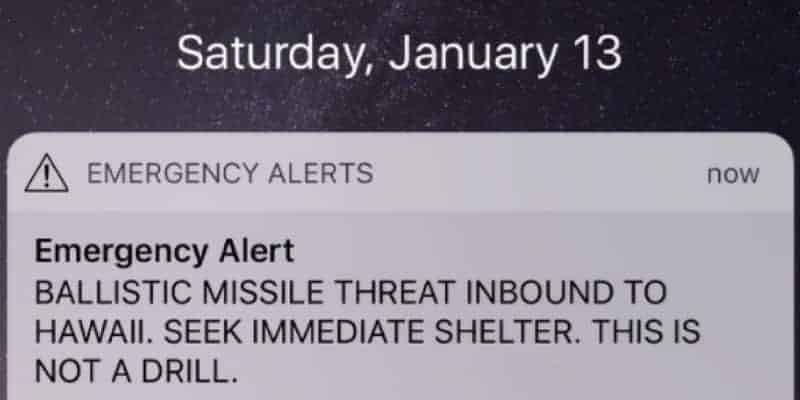(The AEGIS Alliance) – Not long after 8 am local time on Saturday, Hawaii’s emergency alert system sent a shocking message out to its residents: “Ballistic Missile threat inbound to Hawaii. Seek Immediate shelter. This is not a drill.”
This emergency alert was sent out to all cellphones and even interrupted TV stations in Hawaii.
The moment the EAS alert interrupted Hawaiian TV is terrifying pic.twitter.com/pVwpCBeRgD
— Timothy Burke (@bubbaprog) January 13, 2018
Hawaii’s Emergency Management Agency responded very quickly:
NO missile threat to Hawaii.
— Hawaii EMA (@Hawaii_EMA) January 13, 2018
Richard Repoza, Hawaii Emergency Management Agency spokesman has confirmed this was false alarm. He states the agency is attempting to determine what exactly happened.
Rep. Tulsi Gabbard (D-HI) took to Twitter proclaiming the emergency alert was a false alarm:
HAWAII – THIS IS A FALSE ALARM. THERE IS NO INCOMING MISSILE TO HAWAII. I HAVE CONFIRMED WITH OFFICIALS THERE IS NO INCOMING MISSILE. pic.twitter.com/DxfTXIDOQs
— Tulsi Gabbard 🌺 (@TulsiGabbard) January 13, 2018
Hawaiians on Twitter are upset about this false alarm and who would blame them.
@MichaelRobison – So, is this truly a mistake?!!!?? Sirens are going off and people are in absolute panic….
@MatthewBringas – Fuck u hawaii alert system
@mastermindhi – Held my babies and prayed
@KDombri – This mistake caused me to cry…I had a the best morning until I got this stupid notification
Hawaii has been a military defense outpost for a long time, and it sparked fears that North Korea could target their island. The state of Hawaii has been ramping up preparations in advance for potentially a nuclear attack by the North Koreans.
The “Aloha State” is now trying to educate its 1.4 million residents, as well as its visitors, about how to best prepare for a nuclear attack. Hawaii is one of the first states in the U.S. to launch a nuclear preparedness campaign that started on December 1st 2016. Hawaii will reinstate the ‘attack warning’ sirens, which haven’t been tested since the Cold War. The sirens will follow a monthly ‘attention alert’ signal, which is used as a way to warn residents of an incoming hurricane or tsunami.
Hawaii is also holding meetings with the communities and are broadcasting public service announcements on the radio and television in order to prepare people for the possibility of an attack. Gone are the days of “duck and cover” during the Cold War; today, the mantra is “shelter in place,” preferably in concrete structures. Officials are also recommending to have sufficient water and food to survive for 48 hours and to be prepared with supplies to last upwards of 14 days.
If North Korea does launch a missile, officials are estimating it’d only take 20 minutes to reach its destination. It would take around five minutes for the U.S. government to determine where the missile is headed, which would leave around 12 to 15 minutes for public warnings.
Kyle James Lee – The AEGIS Alliance – This work is licensed under a Creative Commons Attribution-ShareAlike 4.0 International License.

